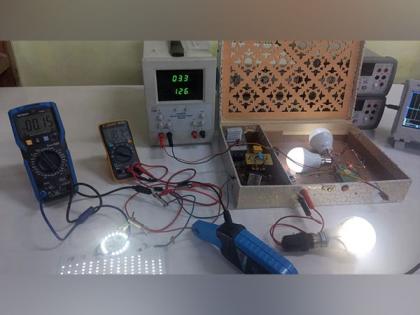Harnessing Radio Frequency for Over-Unity Energy: INFRGY's Breakthrough
By ANI | Published: May 14, 2024 12:39 PM2024-05-14T12:39:56+5:302024-05-14T12:40:03+5:30
VMPL New Delhi [India], May 14: INFRGY LLC, a startup in India, has developed a prototype device that aims ...

Harnessing Radio Frequency for Over-Unity Energy: INFRGY's Breakthrough
VMPL
New Delhi [India], May 14: INFRGY LLC, a startup in India, has developed a prototype device that aims to revolutionize energy generation by harnessing radio waves from the environment. This innovative technology claims to convert radio frequency signals into usable electricity, boasting an "over-unity" effect where the output power surpasses the input power. With promises of sustainable and accessible energy solutions, this advancement holds the potential to reshape the energy landscape.
According to a press release by INFRGY on April 4, 2024, the University of Kashmir's Institute of Technology tested and documented the device. The company states that the additional energy is harvested from the environment, but the exact mechanism remains unclear.
The National Institute of Technology Srinagar is currently evaluating the technology's ability to convert radio waves to DC power, focusing on the claimed output amplification. Further research is planned at other Indian institutions.
Scientific Principles
Law of Conservation of Energy: This fundamental law states that energy cannot be created or destroyed, only converted from one form to another. In simpler terms, you cannot get more energy out of a system than you put in.
Radio Wave Energy: Radio waves carry a specific amount of energy based on their frequency and strength.
Technical Details
INFRGY describes its device as a compact circuit performing multiple functions. It reportedly utilizes a combination of diodes, capacitors, and a rectifying bridge to capture radio frequency (RF) signals and convert them into usable DC power. The company claims the technology's affordability and lack of moving parts make it widely accessible.
Components involved
INFRGY's device seems to rely on a combination of three key components to capture and convert radio waves into usable electricity. Diodes act like tiny one-way gates for electricity, allowing current to flow in only one direction. INFRGY might use these diodes to pick out the specific radio wave signal they want to convert from the environment, similar to how you might tune a radio to a particular station.
Next, capacitors come into play. INFRGY might be using capacitors to smooth out any bumps or fluctuations in the captured radio wave signal before it goes through the final step.
Finally, a rectifying bridge takes center stage. This component acts like a converter, transforming the captured radio waves, which are in the form of alternating current (AC), into direct current (DC). Most electronic devices rely on DC power to function, so this conversion step is crucial for making the captured radio wave energy usable.
Co-founder's Perspective
Parvez Rishi, co-founder of INFRGY, expressed optimism about the technology's future, citing its potential to create a new industry. He acknowledged the assistance of the University of Kashmir and the National Institute of Technology Srinagar in testing and development.
The concept of over-unity devices has been around for decades, but there has yet to be a scientific consensus on their feasibility. Experts generally view such claims with caution due to the fundamental principles of physics, which state that energy cannot be created or destroyed, only converted.
Pervez Rishi emphasizes INFRGY's goal of introducing a technology that incorporates both renewable and wireless energy sources. The ever-growing demand for fossil fuels and the environmental impact they cause have driven innovation in the renewable energy sector.
He envisions INFRGY's device as a way to tap into both renewable and wireless energy sources.
This could represent a significant leap forward in the energy sector. Renewable energy sources, like solar, wind, and geothermal, are becoming increasingly important as we strive to reduce our reliance on fossil fuels.
While the validity of INFRGY's over-unity claims remains to be seen, the company's focus on harvesting ambient energy aligns with the global push for sustainable solutions. Further independent testing and research will be crucial to assess the device's true potential.
Cautions around Over-Unity
Given the law of conservation of energy, scientists generally view claims of over-unity with caution. Here is the breakdown of why:
1. No conversion process is 100% efficient. Some energy is always lost as heat or other forms during the conversion from radio waves to electricity. It's highly unlikely that INFRGY's device could overcome these losses and produce more energy than it absorbs.
2. While INFRGY's device might be really good at converting the radio wave energy, it's very unlikely it can overcome this basic principle. It can't create extra energy, only use what's already there.
3. Maybe there's another way the device gets some of its power, something they haven't told us about yet. This extra power source could be why it seems to make more electricity than the radio waves alone.
Detail video :- https://youtu.be/_hZ6MDlp5Bs, https://youtu.be/dSLryc_z7kw
For more details visit:- https://infrgy.tech/
(ADVERTORIAL DISCLAIMER: The above press release has been provided by VMPL.will not be responsible in any way for the content of the same)
Disclaimer: This post has been auto-published from an agency feed without any modifications to the text and has not been reviewed by an editor
Open in app
